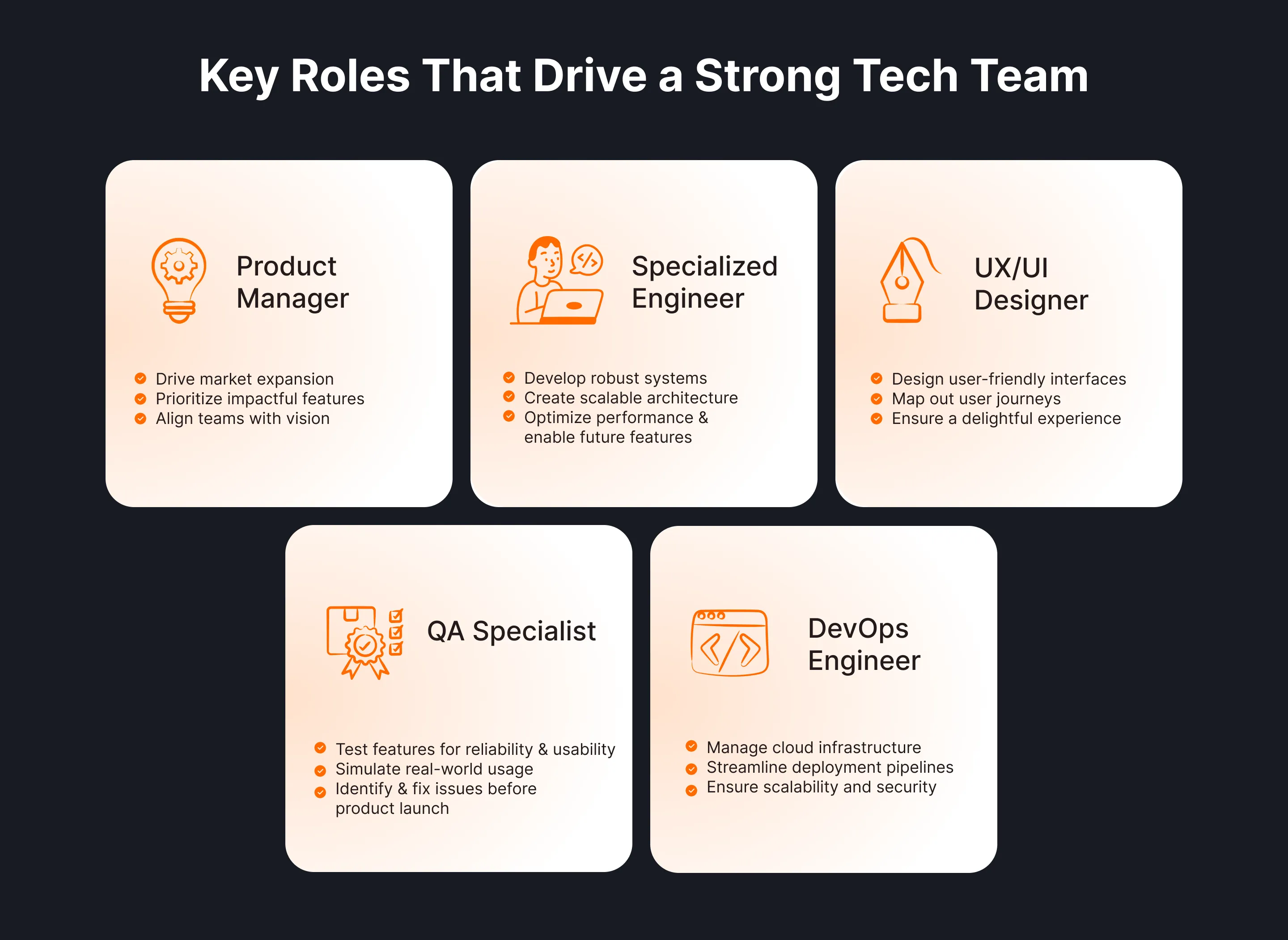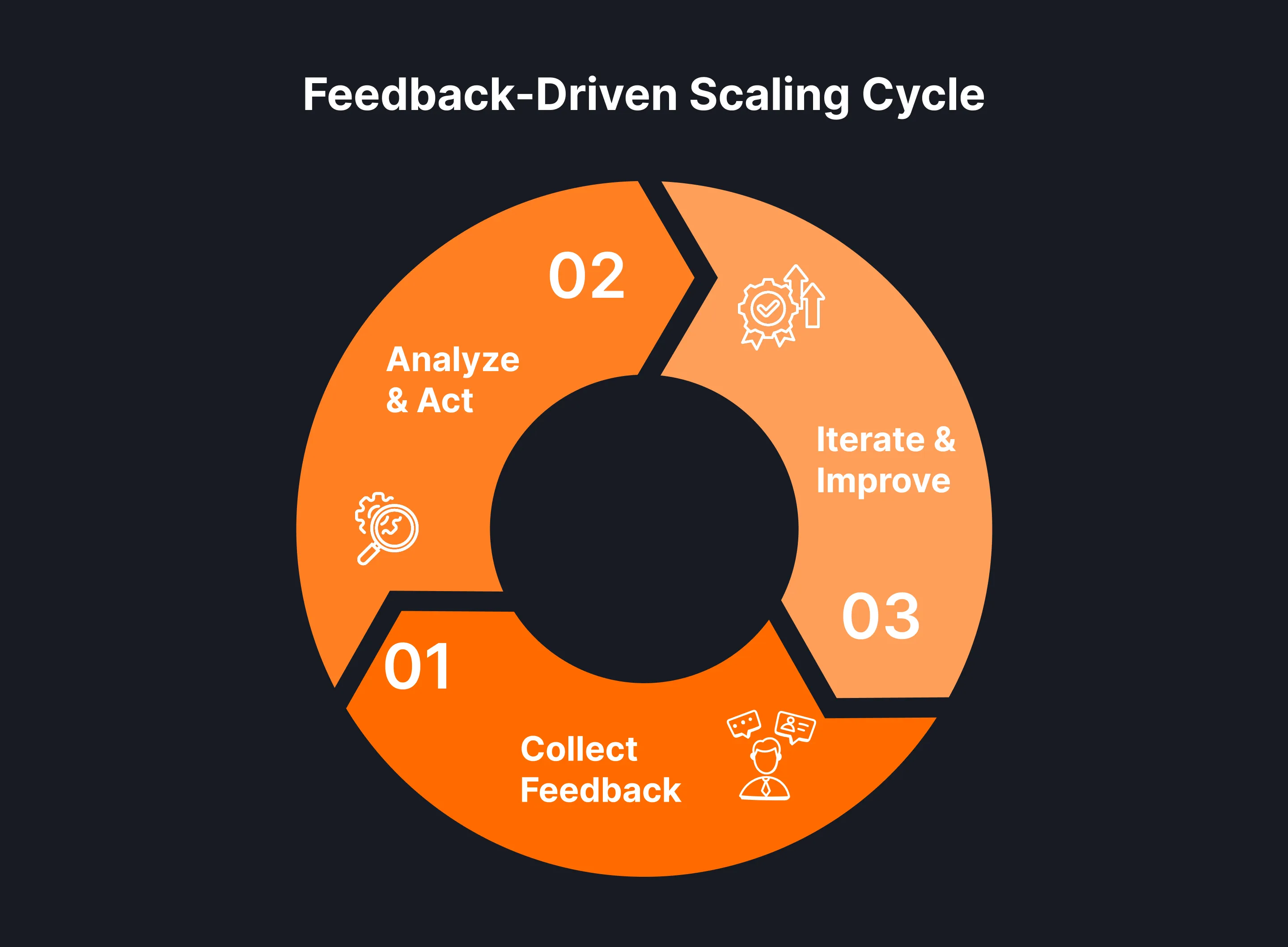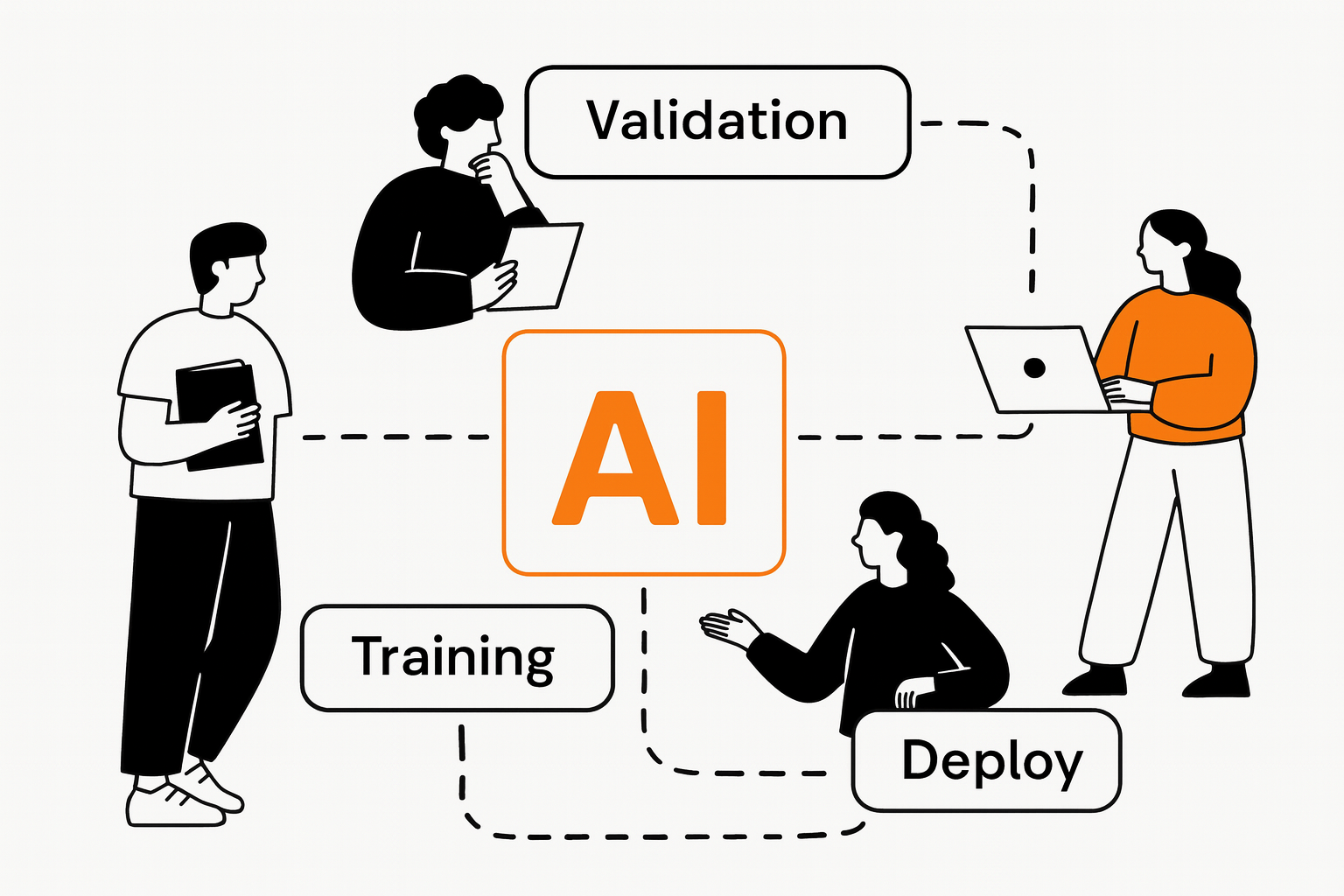4 Key Steps to Building a Tech Team That Drives Growth

Why Speed and Scale Go Hand-in-Hand
Congratulations! You’ve helped lead your team to develop game-changing new software. You’ve locked down the core features and secured that Series B or C funding. With the proof of concept achieved, your product is on the market – and your company on your competitors’ radar.
Now is the time to accelerate your growth. You need to scale your product, expand its features, and drive new market reach – before your competition can react.
To do that, you need to build strong technical teams. Let’s explore how to make it happen and build a technical team that is high-performing, compatible, and focused on continuous development.
.webp)
Step 1: Go Big or Go Home – Prioritize High-Impact Features That Will Drive Growth
At this stage, you need to do more than add mediocre features. You need to create features that will turn your users into advocates. This isn’t about making your product incrementally better – it’s about envisioning and developing features that will make your users tell their friends, “Whoa, you need this in your life, like, yesterday.”
Use the ICE Scoring Model to Make the Call
The ICE Scoring Model can help you target key features. Score them by considering:
- Impact: Will this feature create buzz in the user base? Is it going to drive real progress and success, or is it a simple commodity?
- Ease: How quickly can your team execute their tasks without falling behind on other key projects?
- Confidence: Are you sure users actually want it? If you’re less than certain, scrap it for now.
Ask your team:
- If we only have time to build one feature, which one will create the most excitement in our user base?
- What problem are we leaving unsolved, and what are the opportunity costs of leaving it that way?
Pro tip:
Bring the whole team together for a short, intense session to prioritize. Set a hard timer, score each feature with a SMART approach, make the call, and then run with it!
Step 2: Build a Strong Technical Team of Specialists Who Eat, Sleep, and Breathe Growth
This isn’t the time for generalists. You need specialists who are the best at what they do, who have compatible skills that don’t overlap, and who can prioritize their own tasks while still driving overall productivity and collaboration.
Every hire should bring a specific superpower to the table. We’re talking about Talent Solutions and engineers who can code your program so that it runs at the speed of light, designers who make interfaces so intuitive that users feel your product is an extension of themselves, and product pros who can spot a growth opportunity that’s sitting under a competitor’s nose.

1. The Strategic Product Manager: The Expansion Architect
Your product manager (PM) is your mastermind. He is here to focus your team on new market opportunities and maximize their collaboration to turbo-charge growth.
- What they do: Set the course for market expansion, prioritize the most impactful features, and ensure everyone knows why these features matter.
- Why they matter: More than simply identifying new features and building a technical team, the PM is designing a strategy for conquering new markets and impressing investors.
Ask them:
- What’s the one feature that’ll make our competitors sweat?
- You’ve got six months until the next funding round. What new feature will impress investors the most?
2. Specialized Engineers: The Turbo Coders
Your engineers do more than code; they design systems that are sleek, scalable, and built to last. They’re the architects behind the scenes, ensuring every new feature can handle the load, the users, and the massive influx of data.
- What they do: They do more than write code – they develop robust systems designed for rapid growth. They create scalable architecture, optimize performance, and lay the groundwork for future features.
- Why they matter: High-performing engineers ensure you build strong technical teams that execute fast while also building smart. They make sure every new feature is rock solid and ready for the influx of users.
Ask them:
- What’s the most unconventional scaling solution you’ve found? How’d you do it?
- If you had to build a feature that could handle one million users tomorrow, what’s your plan?
- You’ve got a tech stack budget for just one tool. What’s the absolute must-have for keeping us scale-ready?
3. The UX/UI Designer: The Master of User Delight
At this stage, your designer is thinking beyond simply making the product align with the brand guide. They’re focused on creating an experience that makes users say, “Where has this been all my life?” They take complex features and make them intuitive, helping new users feel like pros in seconds. They understand what grabs users and keeps them coming back.
- What they do: Design interfaces that users love, map out the user journey, and make sure the experience is delightful even as you add increasingly complex features.
- Why they matter: With the right designer your product becomes a joy to use, even as it grows. A high-performing designer keeps the experience clean, smooth, and unforgettable.
Ask Them:
- If our product were a theme park, what would be the main attraction?
- You’re designing for users who’ve never used a product like this before. How do you make it instantly welcoming?
- If you could add just one thing to make our users’ lives easier, what would it be?
4. The QA Specialist: The Product’s Last Line of Defense
Your quality assurance (QA) specialist is the ultimate bug hunter. As you roll out new features, they’re the ones making sure everything works. They’ll find the weak spots, test every possible scenario, and make sure you’re launching features that users can rely on – whether it’s day one or user one million.
- What they do: Test new features for scalability, reliability, and usability. They simulate real-world usage and break things to make sure the final product doesn’t.
- Why they matter: As you scale, reliability is key. A QA specialist makes sure every new feature you launch can hold its own under the stress of rapid growth.
Ask them:
- If you were preparing this product for an alien invasion of users, what would you test first?
- What’s the wildest edge case you’ve caught, and how’d you find it?
- If you could only run one test on a feature to make sure it scales, what would it be?
5. The DevOps Engineer: The Ultimate Enabler
DevOps engineers are like the backstage crew making sure the whole tech show runs smoothly. They automate, optimize, and keep the infrastructure indestructible. With a DevOps pro on board, you can deploy updates fast and handle user spikes without breaking a sweat.
- What they do: Manage cloud infrastructure, streamline deployment pipelines, and make sure everything is scalable and secure.
- Why they matter: DevOps isn’t just about tech – it’s about keeping the whole operation smooth, fast, and efficient.
Ask them:
- If you were preparing our product for the biggest user spike ever, what would you do first?
- What’s the most satisfying automation trick you’ve ever pulled off?
Step 3: Scale Up With Agile Processes That Don’t Slow You Down
You’re growing fast, so you can’t afford to get bogged down by lengthy planning sessions. Agile isn’t just about being fast – it’s about staying flexible and ready to pivot with new insights. By this stage, Agile should be second nature. Here’s a quick refresher on how to stay lean and keep the team moving as you roll out new features and scale.
The Fast-Track Agile Process:
- Sprint planning: Get in, set goals, pick high-impact features, and break. Fast.
- Daily stand-ups: Quick and intense. Share updates, solve roadblocks, and move on.
- Sprint retrospectives: Check what worked, what didn’t, fix it, and go again.
Tools like Jira, Trello, and Asana are designed for Agile processes, and will help you keep everyone on track, organized, and pushing toward the next big with focused decision-making and communication.
Step 4: Put Feedback to Work, Fast
As you expand, user feedback is your best friend. It’s not about getting feedback only for the sake of collecting feedback; it’s about listening, acting, and adapting as quickly as possible. You’re looking for insights that’ll help you fine-tune the product for new markets and audiences while ensuring that you’re meeting all expectations and achieving sustained success.
3 Steps to a Feedback-Driven Scaling Cycle:
- Collect feedback: Use tools like Mixpanel, Hotjar, and UserTesting to track what users are doing and gather insights.
- Analyze and act: Focus on feedback that’ll push you into new markets. What do new users need? What’ll keep them coming back?
- Iterate and improve: Work that feedback into your Agile process so you’re always building the best version possible with constant progress.
Ask users:
- If you could give our product a superpower, what would it be?
- What’s the one thing you’d love us to add next?
- On a scale of 1 to 10, how well are we solving your problem?

Conclusion: Scale Fast, Grow Faster
By this stage, you’re doing more than running a startup; you’re building tech teams and creating an unstoppable growth machine. To keep scaling at full speed, you need a strong technical team, a smart approach, and the willingness to keep developing. Prioritize features that drive real impact, build a technical team with compatible skills and a cultural fit that promotes collaboration and retention, and use Agile processes that keep you lean and flexible.
Ready to bring on the talent you need to make this happen? With Genius Match, you’ll find the pros who deliver solutions for rapid market expansion. Assemble your dream team, expand your product, and take over your market – one game-changing feature at a time.

Building Successful AI-Enabled Technology Teams - A Strategic Framework for the Modern Enterprise
Discover how to build successful AI-enabled teams with proven frameworks, AI developers, and talent management strategies for modern software development.

Genius Match Strengthens Leadership Team with Industry Veterans Helen Prashchur and Elizabeth Jenkins
Genius Match announced the appointment of two seasoned sales executives to drive North American expansion.

The AI-Driven Evolution of Software Development: Why Global Talent and Human Expertise Matter More Than Ever
The software development landscape has undergone a seismic shift. AI assistants now write code, automate complex tasks, and streamline development workflows in ways that seemed impossible just a few years ago. While this revolution has transformed how we build software, it has also created new challenges and misconceptions that are reshaping the entire industry.